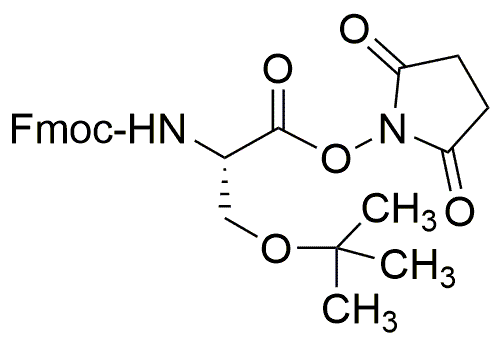Fmoc-O-tert-butyl-L-serine N-hydroxysuccinimide ester is widely utilized in research focused on:
- Peptide Synthesis: This compound serves as a key building block in the synthesis of peptides, allowing researchers to create complex structures with high specificity and efficiency.
- Drug Development: It is used in the development of pharmaceutical compounds, particularly in creating targeted drug delivery systems that enhance therapeutic efficacy.
- Bioconjugation: The chemical is effective in bioconjugation processes, facilitating the attachment of biomolecules to surfaces or other molecules, which is crucial in diagnostics and therapeutic applications.
- Protein Engineering: It aids in modifying proteins to improve their stability and functionality, making it valuable in biotechnology and enzyme engineering.
- Research in Cancer Therapy: This compound is explored in cancer research for its potential to improve the delivery of chemotherapeutic agents directly to tumor cells, enhancing treatment outcomes.
General Information
Properties
Safety and Regulations
Applications
Fmoc-O-tert-butyl-L-serine N-hydroxysuccinimide ester is widely utilized in research focused on:
- Peptide Synthesis: This compound serves as a key building block in the synthesis of peptides, allowing researchers to create complex structures with high specificity and efficiency.
- Drug Development: It is used in the development of pharmaceutical compounds, particularly in creating targeted drug delivery systems that enhance therapeutic efficacy.
- Bioconjugation: The chemical is effective in bioconjugation processes, facilitating the attachment of biomolecules to surfaces or other molecules, which is crucial in diagnostics and therapeutic applications.
- Protein Engineering: It aids in modifying proteins to improve their stability and functionality, making it valuable in biotechnology and enzyme engineering.
- Research in Cancer Therapy: This compound is explored in cancer research for its potential to improve the delivery of chemotherapeutic agents directly to tumor cells, enhancing treatment outcomes.
Documents
Safety Data Sheets (SDS)
The SDS provides comprehensive safety information on handling, storage, and disposal of the product.
Product Specification (PS)
The PS provides a comprehensive breakdown of the product’s properties, including chemical composition, physical state, purity, and storage requirements. It also details acceptable quality ranges and the product's intended applications.
Certificates of Analysis (COA)
Search for Certificates of Analysis (COA) by entering the products Lot Number. Lot and Batch Numbers can be found on a product’s label following the words ‘Lot’ or ‘Batch’.
Numéro de catalogue
Numéro de lot/série
Certificates Of Origin (COO)
This COO confirms the country where the product was manufactured, and also details the materials and components used in it and whether it is derived from natural, synthetic, or other specific sources. This certificate may be required for customs, trade, and regulatory compliance.
Numéro de catalogue
Numéro de lot/série
Safety Data Sheets (SDS)
The SDS provides comprehensive safety information on handling, storage, and disposal of the product.
DownloadProduct Specification (PS)
The PS provides a comprehensive breakdown of the product’s properties, including chemical composition, physical state, purity, and storage requirements. It also details acceptable quality ranges and the product's intended applications.
DownloadCertificates of Analysis (COA)
Search for Certificates of Analysis (COA) by entering the products Lot Number. Lot and Batch Numbers can be found on a product’s label following the words ‘Lot’ or ‘Batch’.
Numéro de catalogue
Numéro de lot/série
Certificates Of Origin (COO)
This COO confirms the country where the product was manufactured, and also details the materials and components used in it and whether it is derived from natural, synthetic, or other specific sources. This certificate may be required for customs, trade, and regulatory compliance.


